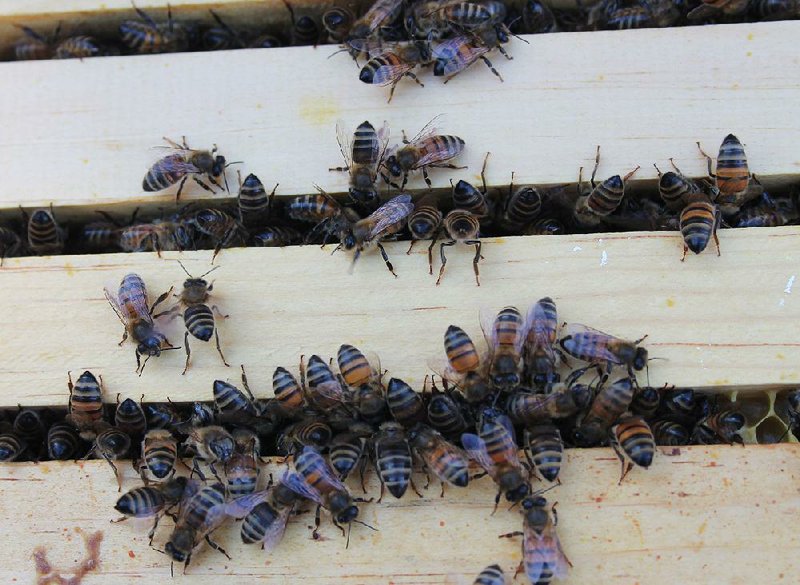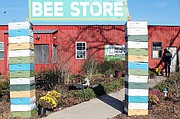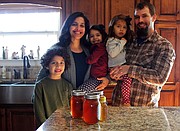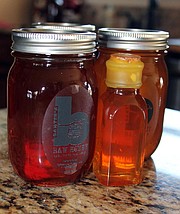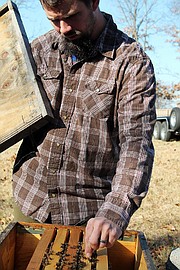If you were a honeybee right now, you would be in your hive with 10,000 or more of your bee sisters and brothers, huddled around your queen to generate heat and keep her warm.
If you are a beekeeper right now, you're hoping your bees are staying warm and healthy in their hives; you're getting boxes ready to keep new hives in and you're looking forward to scooping up all that sweet, golden, yummy honey next year.
In 2017, Arkansas honey production hit its highest mark in at least a decade. About 2.2 million pounds of honey were harvested, according to the U.S. Department of Agriculture, a 35 percent increase from 2016.
That figure is probably low in regards to the state's overall honey output, says Jon Zawislak, extension apiary specialist for the University of Arkansas System Division of Agriculture Cooperative Extension Service, because it includes only producers with five or more hives and leaves out hobbyists with fewer.
"A lot of backyard beekeepers may only have one or two or three hives, and they go underreported," he says, unlike large operations such as Fischer's Honey of North Little Rock or Coy's Honey Farm in Jonesboro.
"There's a steady interest in beekeeping right now," says Zawislak, a beekeeper himself with six or seven hives who sells honey, beeswax candles and other items with his wife and children through their small Walnut Valley Honey Co.
The USDA also noted that the overall number of bee colonies, again among producers keeping five or more, rose 21 percent to about 29,000.
THE HONEY GUY
Beekeeper and honey seller Pat Cullivan of North Little Rock doesn't need government figures to know that more honey is flowing around central Arkansas.
"When I first started selling at the Hillcrest Farmers Market, I was the only honey guy," says Cullivan, who sells not only honey but lotion made from beeswax under his Sun Harvest Honey label. "It was a good deal. Now, four or five years later, all these other farmers are into beekeeping, so I've got a lot of competition. Now there are five or six people other than myself that have honey at Hillcrest Farmers Market."
For Cullivan, who is retired, it keeps him as busy as a bee.
"It fills my day," he says. "I enjoy that. I'm not looking for something to do, I've got something to do."
People have been swiping honey from bees for thousands of years. There's a rock painting in Valencia, Spain, from 6,000 B.C., that shows a person pulling honey from a wild bee colony. Traces of beeswax found on ancient pottery from Europe and north Africa suggest that the first farmers were beekeepers, according to a 2015 study in the journal Nature.
Cullivan started keeping bees in 2008.
"I was gardening with this lady and she said, 'I don't see no bees.'" So he took it upon himself to round up some bees for pollinating purposes and one thing led to another.
"She kept on gardening and I kept on beekeeping," he says. "Now it's gone from keeping bees to packaging and marketing."
Husband and wife Jonathan and Priscilla Baxter of Greenbrier started beekeeping a couple of years ago. They got their first taste when Jonathan, a biologist with the U.S. Fish and Wildlife Service in Conway, was in graduate school at Eastern Kentucky University. One of his professors and her husband were apiarists, which is a fancy way to say beekeepers.
"We helped them extract honey one time," Jonathan Baxter says. "We took the frames from the hive that were ready for harvest and spun the honey out of them. That's how we got hooked."
When they built their house on a large lot two years ago, they finally had enough space to start their own bee yard with two, 3-pound packages of bees ordered through the mail.
OUCH!
Honey expert Winnie-the-Pooh once observed: "When you go after honey with a balloon, the great thing is not to let the bees know you're coming."
Baxter did not heed that advice (although he likely wasn't using a balloon) when he was starting out.
"I got stung a lot," he says with a laugh. "I had no idea what I was doing. I did a lot of YouTube research."
He went into his first winter as a beekeeper with three hives. One survived. Moisture had gotten into the boxes where his hives lived and the bees froze.
Baxter persisted, though, and now has more than 30 hives that he keeps, with permission from landowners, on Cadron Creek between Wooster and Conway and in Menifee. He also has a few in his backyard.
The Baxter family -- which includes Logan, 8, Bella, 4 and Ellie, 2 -- harvested about 300 pounds of honey from their hives this year, Baxter says.
"We eat it," Priscilla Baxter says, with a laugh. They also sell it through their Baxter Apiary Facebook page, at their occasional roadside stand and at farmers markets.
Their operation is one of only three in the state approved by Certified Naturally Grown, a farm assurance program that certifies producers who don't rely on synthetic chemicals or genetically modified organisms, Jonathan Baxter says.
Arkansas beekeepers are regulated by the state plant board, and there are plenty of resources -- including the Arkansas Beekeepers Association (arbeekeepers.org) -- for those looking to start keeping bees.
BEE BUDDIES
Asked what advice he would have for aspiring apiarists, Cullivan says: "Get with another beekeeper or join a local bee club."
The Baxters rely on Central Beekeeper Supply in Russellville, a store that sells equipment, tools and starter hive kits known as "nucs," which is short for nucleus.
"They're amazing. Anytime we have questions, they always help," Priscilla Baxter says.
Near Wrightsville, the family behind Bemis Tree Farm branched out into beekeeping with Bemis Honeybee Farm in 2013. They now sell honey, beekeeping supplies, nucs and have monthly classes for beginners. There is a charge for classes at Bemis, but Zawislak teaches a free course through the University of Arkansas Cooperative Extension Service.
Either way, Jeremy Bemis recommends beginners get some classroom knowledge before buzzing into bee world, and this time of year is perfect.
"In winter, you take classes and buy your equipment so you can get started," he says.
Total cost for startup equipment, ranging from boxes where hives live, tools for extracting honey, protective clothing and other items, runs about $500, he says.
Bemis recommends that newbies -- pun intended-- get two hives to start.
"It's easier to manage two than one," he says. "You might think one hive is doing great, but when you put it next to another hive that's doing really good, you can see there's something wrong. Or you may accidentally kill the queen, or do something that will affect that hive. If you have another one, you can steal some resources and keep them both going."
Oh, and don't expect any honey that first year. The hive needs to grow and will need the honey it makes to survive, he says.
Winter is also the time to order bees in time for Bee Day, Bemis adds.
Bee Day?
Yup. Bemis sells bees they source from other producers and each year beekeepers come to pick up the bees they have ordered on Bee Day. Next year's date is April 27.
"We can have more than 1,000 people here on Bee Day," says Bemis, who runs the tree and bee operation with his wife, Emily, and parents Donna and Tracey, who started the tree farm in 1992. "It's our pickup day, and it's also open to the public."
Bemis also hosts the annual Arkansas Honey Festival in the fall, with honey tasting, honey contests, classes, music and more.
MMMMMM, HONEY
Sampling honey from Baxter's Apiary is an example of how not all raw honey is the same. On their kitchen counter they open three jars, two taken in the spring and one in the fall. Each is from a different location, ranging from their backyard, which has fruit trees, strawberries, blackberries and blueberries, to the hives at Menifee and from a spot on Cadron Creek.
The honey from their yard is a gorgeous light gold and has a wonderfully floral, fruity taste, like a flower shop blew up in a peach orchard and landed in your mouth. Honey from the next jar, which is darker, is richer and not as fruity. The third jar, darker still, is powerfully rich and earthy.
The tastes and color depend on what plants the bees can access -- that darker honey has a lot of goldenrod, Jonathan Baxter says.
A worker bee has a range of about three miles from her hive, so she's not just hitting the same old flora every day and is also cross-pollinating other plants. Once she sucks nectar from a plant, it's stored in a sac in her stomach and she takes it back to the hive where it is passed, mouth-to-mouth, to other bees until its moisture content is reduced and the nectar changes to honey. The honey is then placed in storage cells and capped with beeswax.
Zawislak says: "I can have two hives next to each other in my backyard and the bees in one are pollinating slightly different flowers and that will affect the flavor and aroma and color of the honey."
There's also a difference between honey bought from small apiaries and larger producers.
"If you go to the grocery store and buy honey from a large packer, more than likely it's been filtered and heated up," Zawislak says. "They filter out the pollen and any other particles because it extends the shelf life. All honey will eventually crystallize, but raw honey has never been heated or filtered that way, so it will crystallize a little faster."
For now, though, most bees are using their honey as energy to survive the winter before getting back to work.
"Honeybees are perennial," Zawislak says. "When the spring comes, they will start right up again where they left off."
Style on 12/18/2018
